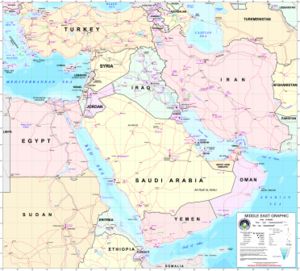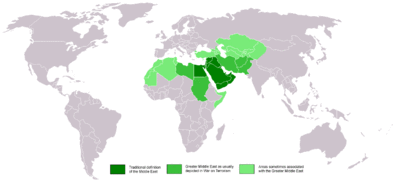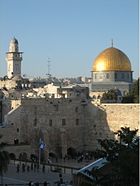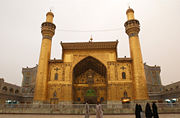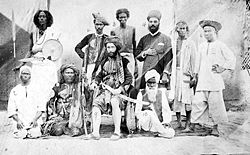Middle East
2008/9 Schools Wikipedia Selection. Related subjects: Geography
The Middle East is a historical and political region of Afro-Eurasia with no clear boundaries. The term "Middle East" was popularized around 1900 in the United Kingdom; it has a loose definition traditionally encompassing countries or regions in Western Asia and parts of North Africa. The corresponding adjective to Middle East is Middle-Eastern and the derived noun is Middle-Easterner.
The history of the Middle East dates back to ancient times, and throughout its history the Middle East has been a major centre of world affairs. The Middle East is also the geographic origin of three of the world’s major religions - Christianity, Islam and Judaism. The Middle East generally has an arid and hot climate, with several major rivers providing for irrigation to support agriculture in limited areas. Many countries located around the Persian Gulf have large quantities of crude oil. In modern times the Middle East remains a strategically, economically, politically, culturally, and religiously sensitive region.
Etymology
The term "Middle East" may have originated in the 1850s in the British India Office, and became more widely known when American naval strategist Alfred Thayer Mahan used the term. During this time the British and Russian Empires were vying for influence in Central Asia, a rivalry which would become known as The Great Game. Mahan realized not only the strategic importance of the region, but also of its centre, the Persian Gulf. He labeled the area surrounding the Persian Gulf as the Middle East, and said that after the Suez Canal, it was the most important passage for Britain to control in order to keep the Russians from advancing towards India. Mahan first used the term in his article "The Persian Gulf and International Relations," published in September 1902 in the National Review, a British journal.
The Middle East, if I may adopt a term which I have not seen, will some day need its Malta, as well as its Gibraltar; it does not follow that either will be in the Persian Gulf. Naval force has the quality of mobility which carries with it the privilege of temporary absences; but it needs to find on every scene of operation established bases of refit, of supply, and in case of disaster, of security. The British Navy should have the facility to concentrate in force if occasion arise, about Aden, India, and the Persian Gulf.
Mahan's article was reprinted in The Times and followed in October by a 20 article series entitled "The Middle Eastern Question," written by Sir Ignatius Valentine Chirol. During this series Sir Ignatius expanded the definition of the "Middle East" to include "those regions of Asia which extend to the borders of India or command the approaches to India." With the series end in 1903, The Times removed quotation marks from subsequent uses of the term.
Until World War II, it was customary to refer to areas centered around Turkey and the eastern shore of the Mediterranean as the " Near East," while the " Far East" centered on China. The Middle East then meant the area from Mesopotamia to Burma, namely the area between the Near East and the Far East. The sense described in this article evolved during the war, perhaps influenced by the ancient idea of the Mediterranean as the "sea in the middle".
One widely used definition of the "Middle East" is that of the airline industry, maintained by the IATA standards organization. This definition — as of early 2007 — includes Afghanistan, Bahrain, Egypt, Iran, Iraq, Israel, Jordan, Kuwait, Lebanon, Pakistan, Palestinian territories, Oman, Qatar, Saudi Arabia, Sudan, Syrian Arab Republic, United Arab Emirates, and Yemen. This definition is used in world-wide airfare and tax calculations for passengers and cargo.
Criticism and usage
Many have criticized the term Middle East for what they see as Eurocentrism, because it was originally used by Europeans (although Mahan was American) and reflects the geographical position of the region from a European perspective. It is also criticized due to the fact that the term today is often used to only refer to the Arab world, making the situation more confused.

Today the term is used by Europeans and non-Europeans alike, unlike the similar term Mashreq, used exclusively in Arabic-language contexts. The region is only east from the perspective of Europe. To an Indian, it lies to the west; to a Russian, it lies to the south. The description Middle has also led to some confusion over changing definitions. Before the First World War, "Near East" was used in English to refer to the Balkans and the Ottoman Empire, while "Middle East" referred to Iran, Kurdistan, Afghanistan, present-day Pakistan and Central Asia, Turkestan, and the Caucasus. In contrast, "Far East" referred to the countries of East Asia (e.g. China, Japan, Korea, Hong Kong, etc.). Some critics usually advise using an alternative term, such as "Western Asia." The official UN designation of the area is "Western Asia."
With the disappearance of the Ottoman Empire in 1918, "Near East" largely fell out of common use in English, while "Middle East" came to be applied to the re-emerging countries of the Islamic world. However, the usage of "Near East" was retained by a variety of academic disciplines, including archaeology and ancient history, where it describes an area identical to the term Middle East, which is not used by these disciplines (see Ancient Near East).
The Eisenhower Doctrine, a 1957 foreign policy of the United States government, was the first to officially use the term Middle East. Secretary of State John Foster Dulles defined the Middle East as "the area lying between and including Libya on the west and Pakistan on the east and Turkey on the North and the Arabian peninsula to the south, plus the Sudan and Ethiopia." In 1958, the State Department explained that the terms " Near East" and "Middle East" were interchangeable, and defined the region as including only Egypt, Syria, Israel, Lebanon, Jordan, Iraq, Saudi Arabia, Kuwait, Bahrain, and Qatar.
The Associated Press Stylebook says that Near East formerly referred to the farther west countries while Middle East referred to the eastern ones, but that now they are synonymous. It instructs:
Use Middle East unless Near East is used by a source in a story. Mideast is also acceptable, but Middle East is preferred.
At the United Nations, the numerous documents and resolutions about the Middle East are in fact concerned with the Arab-Israeli conflict, in particular the Israeli-Palestinian conflict, and, therefore, with the four states of the Levant. The term Near East is occasionally heard at the UN when referring to this region.
Translations
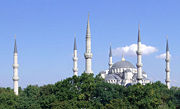
There are terms similar to "Near East" and "Middle East" in other European languages, but since it is a relative description, the meanings depend on the country and are different from the English terms generally. In German the term " Naher Osten" (Near East) is still in common use (nowadays the term "Mittlerer Osten" is more and more common in press texts translated from English sources, albeit having a distinct meaning) and in Russian Ближний Восток or "Blizhniy Vostok", Bulgarian Близкия Изток, Polish Bliski Wschód or Croatian Bliski istok (meaning Near East in all the four Slavic languages) remains as the only appropriate term for the region. However, some languages do have "Middle East" equivalents, such as the French Moyen-Orient and the Italian Medio Oriente..
Perhaps due to the influence of the Western press, the Arabic equivalent of “Middle East,” “الشرق الأوسط” (“ash-sharq-l-awsat”), has become standard usage in the mainstream Arabic press, comprehending the same meaning as the term “Middle East” in North American and Western European usage. The Persian equivalent for Middle East is خاورمیانه (Khāvarmiyāneh - Xâvarmiyâneh in "Unipers").
History
The Middle East lies at the juncture of Eurasia and Africa and of the Mediterranean Sea and the Indian Ocean. It is the birthplace and spiritual centre of the Christianity, Islam, Judaism, Yezidi, and in Iran, Mithraism, Zoroastrianism, Manichaeism, and the Bahá'í Faith. Throughout its history the Middle East has been a major centre of world affairs; a strategically, economically, politically, culturally, and religiously sensitive area.
The earliest civilizations, Mesopotamia and ancient Egypt, originated in the Fertile Crescent and Nile Valley regions of the ancient Near East, as well as the civilizations of the Levant, Persia, and Arabian Peninsula. The Middle East region was first unified under the Achaemenid Empire followed later by the Macedonian Empire. It would be the Arab Caliphates of the Middle Ages, however, that would first unify the Middle East as a distinct region and create the dominant ethnic identity that persists today. The Seljuk Empire would also later dominate the region..
The modern Middle East began after World War I, when the Ottoman Empire, which was allied with the defeated Central Powers, was partitioned into a number of separate nations. Other defining events in this transformation included the establishment of Israel in 1948 and the departure of European powers, notably Britain and France. They were supplanted in some part by the rising influence of the United States.
In the 20th century, the region's significant stocks of crude oil gave it new strategic and economic importance. Mass production of oil began around 1945, with Saudi Arabia, Iran, Kuwait, Iraq, and the United Arab Emirates having large quantities of oil. Estimated oil reserves, especially in Saudi Arabia and Iran, are some of the highest in the world, and the international oil cartel OPEC is dominated by Middle Eastern countries.
During the Cold War, the Middle East was a theatre of ideological struggle between the two superpowers: the United States and the Soviet Union, as they competed to influence regional allies. Of course, besides the political reasons there was also the "ideological conflict" between the two systems. Moreover, as Louise Fawcett argues, among many important areas of contention, or perhaps more accurately of anxiety, were, first, the desires of the superpowers to gain strategic advantage in the region, second, the fact that the region contained some two thirds of the world's oil reserves in a context where oil was becoming increasingly vital to the economy of the Western world [...] Within this contextual framework, the United States sought to divert the Arab world from Soviet influence. Throughout the 20th and into the 21st century, the region has experienced both periods of relative peace and tolerance and periods of conflict and war. Current issues include the Iraq War, Israeli-Palestinian conflict, and the Iranian nuclear program.
Territories and regions
- Arabian Peninsula - Saudi Arabia, Kuwait, Qatar, U.A.E., Oman, Yemen and Bahrain
- Mesopotamia - Iraq
- Persian Plateau - Iran, Afghanistan and Pakistan
- Anatolia - Turkey
- The Levant - Jordan, Lebanon, Syria, Palestinian Authority and Israel
- Northern Africa - Algeria, Egypt, Libya, Morocco and Tunisia
| Country, with flag | Area (km²) |
Population | Density (per km²) |
Capital | GDP (Total) | Per capita | Currency | Government | Official languages | Coat of Arms |
|---|---|---|---|---|---|---|---|---|---|---|
| Persian Plateau: | ||||||||||
| 1,648,195 | 71,208,000 | 42 | Tehran | $753 billion (2007) | $10,600 (2007) | Iranian rial | Islamic Republic | Persian | ||
| 647,500 | 31,889,923 | 46 | Kabul | $35 billion (2007) | $1,000 (2007) | Afghani | Islamic Republic | Persian, Pashto |  |
|
| 880,940 | 169,300,000 | 206 | Islamabad | $505 billion (2007) | $3,320 (2007) | Pakistani Rupee | Islamic Republic | Urdu |  |
|
| Anatolia: | ||||||||||
| 783,562 | 70,586,256 (2007) | 91 | Ankara | $888 billion (2007) | $12,900 (2007) | Turkish new lira | Parliamentary Democracy | Turkish |  |
|
| Mesopotamia: | ||||||||||
| 437,072 | 24,001,816 | 55 | Baghdad | $102.3 billion (2007) | $3,600 (2007) | Iraqi dinar | Parliamentary Democracy (Developing) | Arabic, Kurdish |  |
|
| Arabian Peninsula: | ||||||||||
| 17,820 | 3,100,000 | 119 | Kuwait City | $130.1 billion (2007) | $39,300 (2007) | Kuwaiti dinar | Constitutional Hereditary | Arabic |  |
|
| 665 | 656,397 | 987 | Manama | $24.5 billion (2007) | $32,100 (2007) | Bahraini Dinar | Constitutional monarchy | Arabic |  |
|
| 212,460 | 3,200,000 | 13 | Muscat | $61.6 billion (2007) | $24,000 (2007) | Omani Rial | Absolute monarchy | Arabic |  |
|
| 11,437 | 793,341 | 69 | Doha | $57.7 billion (2007) | $80,900 (2007) | Qatari Riyal | Monarchy | Arabic |  |
|
| 1,960,582 | 23,513,330 | 12 | Riyadh | $564.6 billion (2007) | $23,200 (2007) | Riyal | Absolute monarchy | Arabic |  |
|
| 82,880 | 4,496,000 | 30 | Abu Dhabi | $167.3 billion (2007) | $37,300 (2007) | UAE dirham | Federal Constitutional Monarchy | Arabic |  |
|
| 527,970 | 18,701,257 | 35 | Sanaá | $52 billion (2007) | $2,300 (2007) | Yemeni rial | Republic | Arabic | |
|
| The Levant: | ||||||||||
| 20,770 | 7,029,529 | 290 | Jerusalem1 | $185.9 billion (2007) | $25,800 (2007) | Israeli new sheqel | Parliamentary democracy | Hebrew, Arabic |  |
|
| 92,300 | 5,307,470 | 58 | Amman | $28 billion (2007) | $4,900 (2007) | Jordanian dinar | Constitutional monarchy | Arabic |  |
|
| 10,452 | 3,677,780 | 354 | Beirut | $42.3 billion (2007) | $11,300 (2007) | Lebanese lira | Republic | Arabic |  |
|
| 185,180 | 17,155,814 | 93 | Damascus | $87 billion (2007) | $4,500 (2007) | Syrian pound | Presidential republic | Arabic |  |
|
| Northern Africa: | ||||||||||
| 2,381,740 | 33,333,216 | 14 | Algiers | $224.7 billion (2007) | $6,500 (2007) | Algerian dinar | Presidential republic | Arabic |  |
|
| 1,001,449 | 77,498,000 | 74 | Cairo | $404 billion (2007) | $5,500 (2007) | Egyptian pound | Semi-presidential republic (democracy) | Arabic |  |
|
| 1,759,540 | 6,036,914 | 3 | Tripoli | $74.8 billion (2007) | $12,300 (2007) | Libyan dinar | Jamahiriya | Arabic |  |
|
| 446,550 | 33,757,175 | 70 | Rabat | $125.3 billion (2007) | $4,100 (2007) | Moroccan dirham | Constitutional monarchy | Arabic |  |
|
| 163,610 | 10,102,000 | 62 | Tunis | $77 billion (2007) | $7,500 (2007) | Tunisian dinar | Republic | Arabic |  |
|
| Eastern Africa: | ||||||||||
| 637,661 | 9,588,666 | 13 | Mogadishu | $5.26 billion | $600 | Somali shilling | Semi-presidential republic | Somali, Arabic | Image:Somalicoat.jpg | |
| 2,505,813 | 39,379,358 | 14 | Khartoum | $107.8 billion (2007) | $2,552 (2007) | Sudanese pound | Dictatorship (democracy) | Arabic |  |
|
| Autonomous region: Palestine: | ||||||||||
| 360 | 1,376,289 | 3,823 | Gaza | $5 billion (includes West Bank) (2006) | $1,100 (includes West Bank) (2006) | Israeli new sheqel | Palestinian National Authority Hamas | Arabic | ||
| 5,8602 | 2,500,0003 | 4322,3 | Ramallah | Israeli new sheqel | Palestinian National Authority Fatah | Arabic |  |
|||
1 Under Israeli law. The UN doesn't recognize Jerusalem as Israel's capital.
2 Includes the whole of the West Bank, according to the pre-1967 boundaries.
3 In addition, there are around 400,000 Israeli settlers in the West Bank, of which half are in East-Jerusalem.
Source:
- The World Factbook, United States Central Intelligence Agency (CIA), 15 July 2008.
Demographics
Ethnic groups
The Middle East is home to numerous ethnic groups, including Arabs, Turks, Persians, Jews, Armenians, Georgians, Kurds, Assyrians- Syriacs, Azeris, Circassians, Berbers, Somalis, Greeks, Samaritans, Turkmens, Pashtuns, Baluch, Habesha, and Nubians.
Religions
The Middle East is very diverse when it comes to religions, most of which originated there. Islam in its many forms is by far the largest religion in the Middle East, but other faiths, such as Judaism and Christianity, are also important. There are also important minority religions like Bahá'í, Druze, Yazdanism, Zoroastrianism.
Languages
Languages of the Middle East span many different families, including Indo-European, Afro-Asiatic, and Altaic.
Arabic in its numerous varieties and Persian are most widely spoken in the region, with Arabic being the most widely spoken language in the Arab countries. Other languages spoken in the region include Armenian, Syriac (a form of Aramaic), Azeri, Berber languages, Circassian, Persian, Gilaki language and Mazandarani languages, Hebrew in its numerous varieties, Kurdish, Luri, Turkish and other Turkic languages, Urdu, Punjabi, Somali, Greek. In Turkey, Kurdish, Dimli (or Zaza), Azeri, Kabardian, and Gagauz languages are spoken, in addition to the Turkish language. Several modern South Arabian languages are also spoken.
English is also spoken, especially among the middle and upper class, in countries such as Egypt, Jordan, Israel, Iraq, Pakistan and Kuwait. French is spoken in Algeria, Israel, Lebanon, Morocco, Syria, and Egypt. Urdu is spoken in many Middle Eastern countries, such as Pakistan and Arab states the United Arab Emirates, Israel, and Qatar, which have large numbers of Pakistani immigrants. The largest Romanian-speaking community in the Middle East is found in Israel, where as of 1995 Romanian is spoken by 5% of the population. Romanian is spoken mostly as a secondary language by people from Arab-speaking countries that made their studies in Romania. It is estimated that almost half a million Middle Eastern Arabs studied in Romania during the 1980s. Russian language is also spoken by a large portion of the Israeli population, due to emigration in the late 1990s.
Economy
Middle Eastern economies range from nations being very poor (such as Gaza and Yemen) to extremely wealthy nations (such as UAE and Saudi Arabia). Overall, as of 2007, according to the CIA World Factbook, all nations in the Middle East are maintaining a positive rate of growth.
According to the International Monetary Fund's World Economic Outlook Database of April 2008, the three largest Middle Eastern economies in 2007 were Turkey ($ 663,419,000,000), Saudi Arabia ($ 376,029,000,000) and Iran ($ 294,089,000,000) in terms of Nominal GDP; and Turkey ($ 887,964,000,000), Iran ($ 752,967,000,000) and Saudi Arabia ($ 564,561,000,000) in terms of GDP-PPP. When it comes to per capita (PPP) based income, the three highest ranking countries are Qatar ($80,900), Kuwait ($39,300) and the United Arab Emirates ($37,300). The two lowest ranking countries in the Middle East, in terms of per capita income (PPP) are Afghanistan ($1,000) and the autonomous Palestinian Authority of Gaza and the West Bank ($1,100).
The economic structure of Middle Eastern nations are different in the sense that while some nations are heavily dependent on export of only oil and oil-related products (such as Saudi Arabia, the UAE and Kuwait), others have a highly diverse economic base (such as Turkey and Egypt). Industries of the Middle Eastern region includes oil and oil-related products, agriculture, cotton, cattle, dairy, textiles, leather products, surgical instruments, defence equipment (guns, ammunition, tanks, submarines, fighter jets, UAVs, and missiles). Banking is also an important sector of the economies especially in the case of UAE, and Bahrain. Tourism, with the exception of Turkey and Egypt, remains largely unexplored and is underdeveloped due to the conservative nature of the region as well as the political turmoil in certain regions of the Middle East. In recent years, however, countries such as the UAE, Bahrain, and Jordan have begun experiencing greater number of tourists due to improving tourist facilities and the relaxing of tourism-related policies.
Major economic and financial centers
Unemployment
Unemployment is notably high in the Middle East and North Africa region, particularly among young people aged 15-29, a demographic representing 30% of the region’s total population. The total regional unemployment rate in 2005, according to the International Labor Organization, was 13.2%, and among youth is as high as 25%, up to 37% in Morocco and 73% in Syria..
